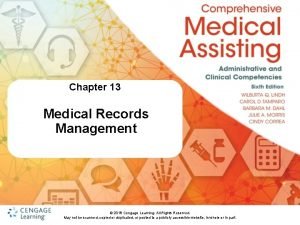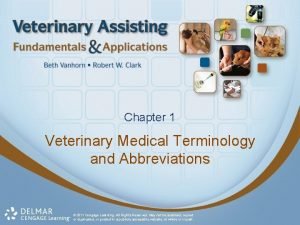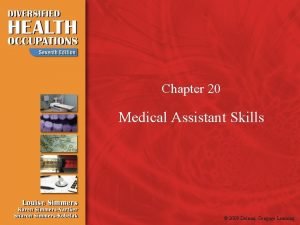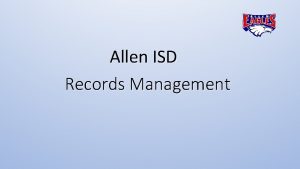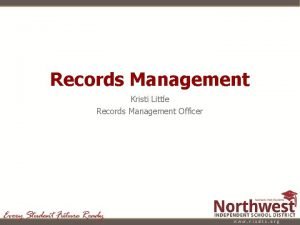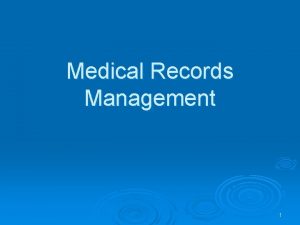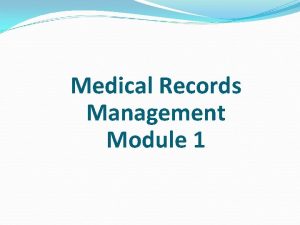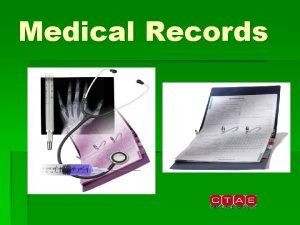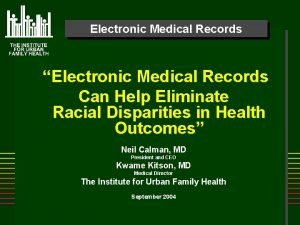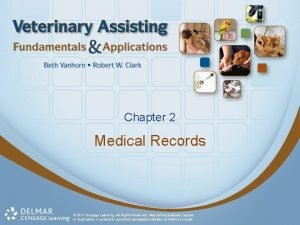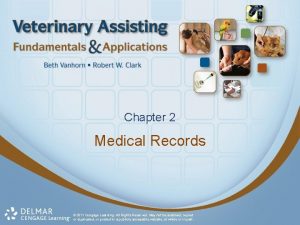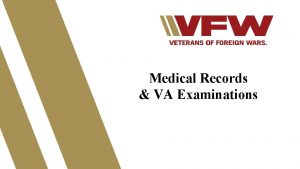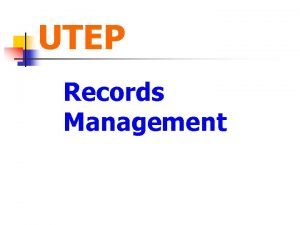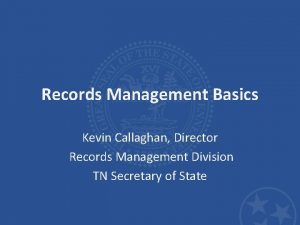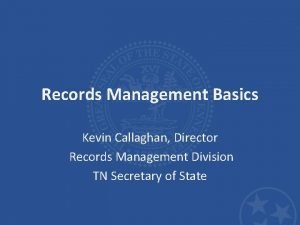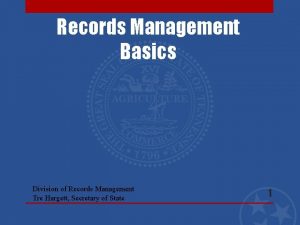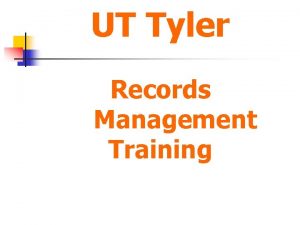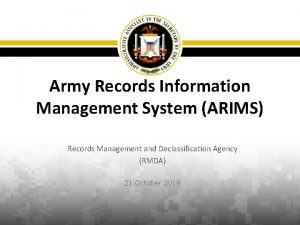Chapter 13 Medical Records Management 2018 Cengage Learning






















- Slides: 22

Chapter 13 Medical Records Management © 2018 Cengage Learning. All Rights Reserved. May not be scanned, copied or duplicated, or posted to a publicly accessible website, in whole or in part.

Purpose of Medical Records • Provide base for managing patient care • Provide interoffice and intraoffice communication as necessary • Determine any patterns that surface to signal provider of patient needs • Serve as basis for legal information to protect providers, staff, patients • Provide clinical data for research © 2018 Cengage Learning. All Rights Reserved. May not be scanned, copied or duplicated, or posted to a publicly accessible website, in whole or in part. 2

Ownership of Medical Records • Property of those who create record • Information belongs to patient and is protected with privacy and confidentiality • Patients are allowed access to their medical records and can ask certain information be added or excluded from their file • Providers who include their patients in their medical record keeping foster trust and respect with their patients © 2018 Cengage Learning. All Rights Reserved. May not be scanned, copied or duplicated, or posted to a publicly accessible website, in whole or in part. 3

Authorization to Release Information • Before information released from medical record, patient notified and written approval received • Identify reason for release and what information specifically requested • Only that information released • Does not include release of information to patient’s chosen insurance carrier © 2018 Cengage Learning. All Rights Reserved. May not be scanned, copied or duplicated, or posted to a publicly accessible website, in whole or in part. 4

Manual or Electronic Medical Records • Mixture of manual, or paper, medical records, and electronic medical records (EMR) • Goal was to have EMRs by 2014 • EMR advantages and disadvantages • 2009, American Reinvestment and Recovery Act (ARRA): Incentives for physicians and hospitals to make transition to EMR • EMR provides easy retrieval of information • All documentation must be accurate and complete © 2018 Cengage Learning. All Rights Reserved. May not be scanned, copied or duplicated, or posted to a publicly accessible website, in whole or in part. 5

The Importance of Accurate Medical Records (Slide 1 of 3) • Accuracy essential to patient care • Critical to facility’s smooth functioning • Important when referring patient to outside specialists • Essential in controlling costs • May be needed in medical litigation • If there is no record of any information related to the patients care, it did not happen © 2018 Cengage Learning. All Rights Reserved. May not be scanned, copied or duplicated, or posted to a publicly accessible website, in whole or in part. 6

The Importance of Accurate Medical Records (Slide 2 of 3) • Creating paper and electronic records • Chart prepared on or before day of patient’s first visit - Paper medical records require assembly of appropriate file folders and forms - Electronic medical charts prepared in much the same manner except that all information stored electronically - EMR provides an orderly arrangement of patient information © 2018 Cengage Learning. All Rights Reserved. May not be scanned, copied or duplicated, or posted to a publicly accessible website, in whole or in part. 7

The Importance of Accurate Medical Records (Slide 3 of 3) • Correcting medical records - Paper medical record • Draw single line using red ink pen through error • Make correction • Write Corr. or Correction above area corrected • Indicate your initials and current date • Never obliterate • Forensic experts able to determine when and how corrections were made • EMR errors are corrected differently © 2018 Cengage Learning. All Rights Reserved. May not be scanned, copied or duplicated, or posted to a publicly accessible website, in whole or in part. 8

Types of Medical Records (Slide 1 of 4) • Problem-oriented medical records (POMRs) - Vital identification data, immunizations, allergies, medications, problems - Identified by a number that corresponds to charting relevant to that problem number - Each problem followed with the progress notes - Used by family practitioners, pediatricians and internists © 2018 Cengage Learning. All Rights Reserved. May not be scanned, copied or duplicated, or posted to a publicly accessible website, in whole or in part. 9

Types of Medical Records (Slide 2 of 4) • The SOAP approach for progress notes - Subjective impressions - Objective clinical evidence - Assessment or diagnosis - Plans for further management • Some facilities use additional chart tools - Education for patient - Response of patient OR - Implementation of the plan (what’s to be done) - Evaluation, indicating effective care or results © 2018 Cengage Learning. All Rights Reserved. May not be scanned, copied or duplicated, or posted to a publicly accessible website, in whole or in part. 10

Types of Medical Records (Slide 3 of 4) • Source-oriented medical records (SOMRs) - Groups information according to its source - Makes different types of information quickly accessible - Many providers use SOAP method to record their chart notes - SOMR does not have problem list - Many EMR software packages use POMR or SOMR format © 2018 Cengage Learning. All Rights Reserved. May not be scanned, copied or duplicated, or posted to a publicly accessible website, in whole or in part. 11

Types of Medical Records • Strict chronological arrangement - Data filed strictly with most recently charted materials to top of folder - Difficult for provider or MA to quickly assess patient’s clinical picture - May fit specialty office where patients seen on short-term basis, such as a dietician, radiologist, physical therapist © 2018 Cengage Learning. All Rights Reserved. May not be scanned, copied or duplicated, or posted to a publicly accessible website, in whole or in part. 12

Basic Rules for Filing (Slide 1 of 3) • Alphabetizing is key • Indexing rules developed by Association of Medical Records Administrators (AMRA) • Indexing units - Unit identifies each part of a name - Each unit identified according to unit 1 - Applied to individual names, organizations, clinics © 2018 Cengage Learning. All Rights Reserved. May not be scanned, copied or duplicated, or posted to a publicly accessible website, in whole or in part. 13

Basic Rules for Filing (Slide 2 of 3) • Filing patient charts - Rule 1: Filed according to last name, first name, middle name, succeeding names - Rule 2: Single letters are filed before full names. - Rule 3: Prefixes are filed as one unit without spacing, punctuation, or special capitalization - Rule 4: Titles are considered separate units - Rule 5: Hyphenated names are filed as one unit - Rule 6: File married women by legal name (may be different from married name) © 2018 Cengage Learning. All Rights Reserved. May not be scanned, copied or duplicated, or posted to a publicly accessible website, in whole or in part. 14

Basic Rules for Filing (Slide 3 of 3) • Filing patient charts (continued) - Rule 7: Seniority and degrees are used only to distinguish identical names - Rule 8: Mac and Mc are filed alphabetically - Rule 9: Numeric seniority terms are filed before alphabetic terms • Filing identical names - Index by address - (1) City, (2) state, (3) street name, (4) address © 2018 Cengage Learning. All Rights Reserved. May not be scanned, copied or duplicated, or posted to a publicly accessible website, in whole or in part. 15

Steps for Filing Medical Documentation in Patient Files • Inspect • Index • Code • Sort • File © 2018 Cengage Learning. All Rights Reserved. May not be scanned, copied or duplicated, or posted to a publicly accessible website, in whole or in part. 16

Filing Techniques and Common Filing Systems • Color-coding - Tab-alpha system/alpha-Z system • Alphabetic filing • Numeric filing - Straight numeric or terminal/middle digit - Components of numeric filing • Miscellaneous • Alphabetic • Accession record • Subject filing © 2018 Cengage Learning. All Rights Reserved. May not be scanned, copied or duplicated, or posted to a publicly accessible website, in whole or in part. 17

Filing Procedures (Slide 1 of 2) • Cross-referencing - Stores files for quick and accurate retrieval - Identify primary label and create proper file - Identify alternatives and create dummy chart that refers to location of primary file • Tickler files - Reminder to follow up with required action • Release marks • Checkout system • Locating missing files or data © 2018 Cengage Learning. All Rights Reserved. May not be scanned, copied or duplicated, or posted to a publicly accessible website, in whole or in part. 18

Filing Procedures (Slide 2 of 2) • Filing chart data - Clinical notes - Correspondence - Lab reports • Retention and purging - Record purging to sort through active, inactive, and closed files - Remove any files no longer needed © 2018 Cengage Learning. All Rights Reserved. May not be scanned, copied or duplicated, or posted to a publicly accessible website, in whole or in part. 19

Correspondence • Filing procedures for correspondence - Remove paper clips and staple items together - Inspect to see if item is ready to be filed - On incoming correspondence, be sure letterhead is related to letter - On outgoing correspondence, look at inside address and reference line - On incoming or outgoing correspondence, code indexing units of designated label - Create miscellaneous folder for items that do not have enough to warrant individual folder © 2018 Cengage Learning. All Rights Reserved. May not be scanned, copied or duplicated, or posted to a publicly accessible website, in whole or in part. 20

Electronic Medical Records (Slide 1 of 2) • Government mandated; one day will replace all paper/manual medical records • Fewer human errors • Create, store, edit, retrieve patient data • Allow more than one person to access chart at same time • Keeps record of all patient visits • Practice management software • EMR is fully recognized as a legal document © 2018 Cengage Learning. All Rights Reserved. May not be scanned, copied or duplicated, or posted to a publicly accessible website, in whole or in part. 21

Electronic Medical Records (Slide 2 of 2) • Archival Storage - Medical records preserved for life of practice - Resolve space issues through EMRs - Records copied onto optical disks or CDs - Should have backup system • Transfer of data - EMRs easily emailed in whole or in part - Faxing/scanners (optical character recognition) • Confidentiality - Major issue for storage and transfer of data © 2018 Cengage Learning. All Rights Reserved. May not be scanned, copied or duplicated, or posted to a publicly accessible website, in whole or in part. 22
 2009 delmar cengage learning
2009 delmar cengage learning Delmar cengage learning medical terminology
Delmar cengage learning medical terminology Chapter 13 medical records management workbook answers
Chapter 13 medical records management workbook answers Cengage chapter 5 medical terminology
Cengage chapter 5 medical terminology Cengage medical terminology chapter 1
Cengage medical terminology chapter 1 Gbmc infoweb
Gbmc infoweb Torrance memorial map
Torrance memorial map Cartersville medical center medical records
Cartersville medical center medical records The human respiratory system chapter 7 handout
The human respiratory system chapter 7 handout Color blindness medical term cengage
Color blindness medical term cengage Cengage medical terminology
Cengage medical terminology Chapter 5 the cardiovascular system
Chapter 5 the cardiovascular system Cengage learning heart diagram
Cengage learning heart diagram South-western cengage learning
South-western cengage learning 2009 delmar cengage learning
2009 delmar cengage learning Cengage learning heart diagram
Cengage learning heart diagram Medical terminology chapter 1 answer key
Medical terminology chapter 1 answer key Cengage learning australia
Cengage learning australia 2009 delmar cengage learning
2009 delmar cengage learning Cengage learning
Cengage learning Cengage learning
Cengage learning Wadsworth cengage learning
Wadsworth cengage learning Cengage learning
Cengage learning


